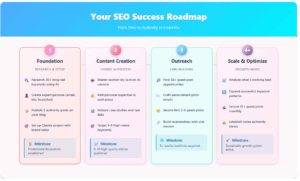Google can be a secretive company when it comes to updates and algorithm changes. However, one thing the company is not secretive about is its goal to provide its users with the highest-quality, most relevant content from industry experts.
Old search engine optimization (SEO) practices involved buying spammy links and stuffing short content pieces with keywords, and search engines rewarded these efforts with higher rankings. That is no longer the case as Google continues to change its algorithms to serve its users better.
Although Google prefers to keep marketers and SEOs guessing about its best practices, the search engine’s release of Search Quality Rating Guidelines discloses how it evaluates pages and websites. These guidelines are used to train Quality Raters (QR), who are individuals hired by Google to sift through sites and evaluate them based on certain criteria. QRs are given search queries to enter into Google, so they can determine how well the highest-ranking pages meet the search engine’s criteria. In 2019, Google updated the Search Quality Rating Guidelines to place more of a focus on E-A-T.
What is E-A-T?
E-A-T is not a new phrase in the world of SEO and content creation. The acronym stands for Expertise, Authority, and Trustworthiness. Although it has been briefly brought up in conversation for nearly seven years, E-A-T did not gain momentum as a key factor of Google Rankings until the Medic Update of 2018. Since then, we have seen a great push towards incorporating E-A-T into content creation and SEO best practices.
Expertise
Google Quality Raters are trained to evaluate a page’s or website’s expertise, and for this reason, Google’s algorithm likely evaluates this as well. The author or website owner must be an expert on the topic and have extensive experience writing about related topics.
Authority
A website’s content must be written by a person or publication that has the authority to speak on the topic. Although it helps to have a lot of followers, recognition, or awards, content can still be authoritative without these things. Writing content that you have authority to speak on and proving you have this authority will get your website a high E-A-T score.
Trustworthiness
Google wants to provide its users with trustworthy content, and there are several ways that Quality Raters can judge the trustworthiness of the content. Privacy policies, editorial guidelines, and security measures are a few things Quality Raters will check for to evaluate your E-A-T.
What Websites Need High E-A-T?
E-A-T is specifically important for Your Money Your Life (YMYL) websites. This content is classified as having an impact on a person’s happiness, health, safety, or financial stability. At Rank Fuse, we work with several clients who are considered YMYL, including mortgage lenders, private equity firms, and law practices. Although these companies must pay special attention to maintaining high E-A-T, websites like fashion blogs, gossip forums, and humor or satire sites should also incorporate expertise, authority, and trust into their content. For example, you may not have professional training on a topic but your extensive life experience as given you authority to speak on the topic.
Depending on the site’s purpose, Quality Raters will evaluate the content’s E-A-T differently. YMYL pages need the highest E-A-T possible; however, all webpages should include expert content that is beneficial to the user.
What Are the Other Factors of High-Quality Content?
In addition to E-A-T, Google highlights several other factors of high-quality content, including the website’s reputation and user experience. All high-quality content has a beneficial purpose. Whether it is to inform, entertain, or offer a product or service, each page on a website must provide a beneficial purpose to users visiting the site.
Although the Search Quality Evaluator Guidelines outline these three characteristics, you should not stop there. Your content must also be well-written and typo-free. It must be professional and use an appropriate tone for the topic. Your written content strategy must be built around keyword research, but your content should not be stuffed with keywords. Squeezing keywords where they do not fit was a common SEO practice in the past. Today, however, both Google and users see this as inauthentic, and Google penalizes the page or blog.
How Does E-A-T Affect SEO?
Although Google has shared what its Quality Raters evaluate, there is no actual proof that these evaluations affect rankings or that the algorithm tests the E-A-T score of your content. It is safe to assume that it does, however. Building a content strategy around these three factors certainly won’t hurt your rankings because Google rewards high-quality content from industry experts. If the content encompasses high E-A-T, is user-focused, and has a good reputation, other sites are more likely to use this content as a resource and link to it within their content.
The more links your site gets, the better Google perceives your reputation and E-A-T. Therefore, your ranking organic search rankings are likely to increase when you build an SEO and content strategy around E-A-T and these other qualities.

How to Improve E-A-T
E-A-T and other characteristics of high-quality content can seem unattainable if you are starting from scratch. Luckily, Google’s Search Quality Rating Guidelines outline what the search engine looks for, and when we put this into practice, we have a checklist of everything to do to achieve high E-A-T. It is important to remember that this will not happen overnight, but the following are several things to keep in mind when creating a website and developing a content strategy.
1. Create and Optimize Home and About Pages
Part of expertise and authority is clearly communicating who you are and what you do. This should be clear on each page of your website, but especially on your home and about page. Include your story, experience, and any anecdotes that will add to your credibility. For example, you can have an about page that lists the leadership team or all employees if your organization is small. Each person can also have a short bio that explains their experience and why they are qualified to speak on the topic. It doesn’t have to be this complicated, though. Other ways to do this include sharing a few sentences about the founding of your company on the home page or descriptions of the services you provide.
2. Consider Authorship for Blogs or Articles
By now, you can probably tell that the individuals who write content for your site must have the proper authority and expertise to do so. It is always better to have the president of a company writing blogs than an intern.
If your website accepts content from guest contributors, ensure that they have the appropriate clout to discuss the topic they are pitching. Sharing editorial guidelines will show that you do your due diligence to find the best contributors. This also portrays trustworthiness by sharing your process for creating, editing, and publishing content.
3. Share Contact Information
One of the best ways to build trust and show transparency is to make it clear to users how they can reach out to you. You can do this by including your phone number and address on the footer of each page. You may want something more elaborate, so for this, you can include a “Contact Us” page with a form to fill out as well as a live chat feature on your website. Giving your users a clear way to contact you will help you earn higher E-A-T.
4. Share Reviews, Testimonials, and Case Studies
Another way to improve your website’s E-A-T is to share what other people have to say about you, your business, and your products or services. Sharing reviews and testimonials on your site will enhance your trustworthiness. Case studies are also wonderful pieces of content that allow you to use real-life examples to explain why you are good at what you do.
Reviews on other websites, such as Yelp and Better Business Bureau, are thought to influence a company’s E-A-T and reputation. Of course, it is always good to have positive reviews for your business. However, Google algorithms can crawl these sites to find information about your company and determine whether your site has the qualities of high-quality content and E-A-T.
5. Enhance Security and Update Privacy Policy
Both Internet users and search engines value trustworthiness. Users want to know that the content they are consuming is truthful and ethical. Many users also prefer companies who take extreme measures to protect consumer data or at least disclose how they use this data.
First, you should create a privacy policy if you don’t already have one and share it on your website. Include how you plan to collect and use data. This is especially important if your business collects credit card information, addresses, or any other personal information. It is also a good idea to review this privacy policy occasionally. Update your policy when necessary to make sure you are maintaining industry standards when it comes to privacy.
In addition to disclosing your privacy policy, your site should have the necessary security measures in place. Google will always view secure websites as more trustworthy, and therefore, rank them higher among competitors. Research the security standards for your industry and ensure you are meeting, if not exceeding, these best practices.
6. Revamp Old, Low E-A-T Content
Websites that have been around for a while may have old content that is short and poorly written with low E-A-T. If your company ever posted short blogs that were stuffed with keywords (many sites did not too long ago), it is probably time to revamp this content and makes sure it meets all the same guidelines of the fresh content you are publishing. Content refreshes are beneficial to include when developing your content strategy, especially for sites with a large backlog of old blogs or pages.
Google never gives us a lot of information to work with, and we are often left guessing, optimizing, and trying to find what works. Luckily for us, Google has given us a look into what their Quality Raters consider when evaluating content. Continuously striving for high E-A-T will certainly help increase your website’s search rankings.
At Rank Fuse Digital Marketing, our content team has plenty of experience writing content with E-A-T in mind. If you want to ensure your website features only the highest-quality content, our content team is here to help. Contact us today for more information!





